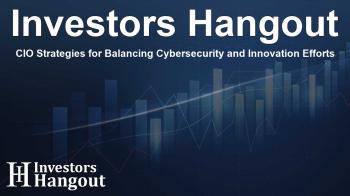CIO Strategies for Balancing Cybersecurity and Innovation Efforts

Understanding the CIO's Role in Today's Digital Landscape
In a world where technology evolves at an unprecedented pace, Chief Information Officers (CIOs) face the daunting task of balancing innovation with robust cybersecurity. A recent study reveals that over 41% of CIOs identify cybersecurity threats as their primary concern. However, the same study highlights that a significant 77% of these leaders are increasing their cybersecurity budgets, suggesting a proactive approach to safeguarding their organizations.
Investing in Security and Innovation
The insights from the Future Forward: CIO 2025 Outlook report by Experis shed light on how technology leaders are not merely reacting to threats but also investing in capabilities that foster innovation. Approximately 68% of CIOs are expanding their cloud infrastructures, while 67% are harnessing the power of artificial intelligence (AI). This strategic blending of security enhancements and innovative practices showcases a modern approach to CIO responsibilities.
Key Findings from the Study
- Security Concerns Dominate: 41% of CIOs cite cybersecurity as their top issue.
- Budget Allocations: 77% plan to bolster cybersecurity funding.
- Talent Scarcity: 76% report challenges in finding skilled tech professionals.
- AI Integration: 52% are incorporating AI skills into current roles rather than creating new positions.
- Collaborative Leadership: The relationship between CIOs and Chief Operating Officers (COOs) is highlighted as crucial for effective leadership.
- Awareness Gaps: 56% of IT leaders feel that senior management lacks adequate understanding of the CIO's role.
This dual focus on security and innovation is increasingly important, particularly as technology leaders explore the potential of AI. While many recognize its transformative capabilities, actual adoption has been cautious. Only 37% view generative AI as immediately beneficial, indicating a recognition of its potential alongside its current limitations.
Regional Variations in Technology Leadership
Insights from the research also reveal significant variations in how CIOs across different regions address these challenges. In certain regions, like the Netherlands, technology leaders are leading the charge in sustainability while still prioritizing security. In contrast, Italian CIOs demonstrate enthusiastic adoption of AI while simultaneously increasing their investments in cybersecurity, illustrating a flexible and versatile approach to technology management.
The Maturity of Organizations
The report categorizes organizations into five maturity levels, identifying "Front Runners" as those with advanced, customer-focused tech strategies. Meanwhile, "Snoozers" express skepticism toward innovative solutions like AI, indicating an essential distinction in how businesses approach digital transformation.
Adapting to Rapid Changes in Technology
Today's CIOs must adapt quickly to changing technologies and threats, often blending risk management with strategic foresight. As they navigate the complexities of cybersecurity while pushing for innovation, the most effective leaders cultivate resilience throughout their organizations. Sam Adams, a technology executive, states that embedding security into the very fabric of business strategy enables progress rather than hinders it. Companies investing in these dual aspects are likely to superiorly position themselves in an increasingly competitive landscape.
For further insights into how CIOs can successfully manage these pressures and maintain organizational competitiveness, it is imperative to explore the evolving landscape of technology and its implications for leadership practices. The strategies that CIOs adopt today will shape the future of technological innovation and cybersecurity.
Frequently Asked Questions
What is the primary concern for CIOs according to the study?
The study reveals that cybersecurity threats are the top concern for 41% of CIOs globally.
How are CIOs approaching AI technologies?
CIOs are cautiously exploring AI, with many organizations either in the exploratory phase or actively implementing AI solutions.
What does the report say about the relationship between CIOs and COOs?
The relationship with COOs is identified as the most critical partnership outside of the IT realm, emphasizing collaboration for organizational success.
How do different regions approach technology challenges?
Regions exhibit varied strategies; for example, tech leaders in the Netherlands focus on sustainability, while Italian CIOs are keen on increasing their AI investments alongside cybersecurity.
What are the five maturity categories identified in the study?
The study categorizes organizations as Front Runners, Innovators, Adapters, Followers, and Snoozers, highlighting varying approaches to technology and change management.
About The Author
Contact Dylan Bailey privately here. Or send an email with ATTN: Dylan Bailey as the subject to contact@investorshangout.com.
About Investors Hangout
Investors Hangout is a leading online stock forum for financial discussion and learning, offering a wide range of free tools and resources. It draws in traders of all levels, who exchange market knowledge, investigate trading tactics, and keep an eye on industry developments in real time. Featuring financial articles, stock message boards, quotes, charts, company profiles, and live news updates. Through cooperative learning and a wealth of informational resources, it helps users from novices creating their first portfolios to experts honing their techniques. Join Investors Hangout today: https://investorshangout.com/
The content of this article is based on factual, publicly available information and does not represent legal, financial, or investment advice. Investors Hangout does not offer financial advice, and the author is not a licensed financial advisor. Consult a qualified advisor before making any financial or investment decisions based on this article. This article should not be considered advice to purchase, sell, or hold any securities or other investments. If any of the material provided here is inaccurate, please contact us for corrections.

